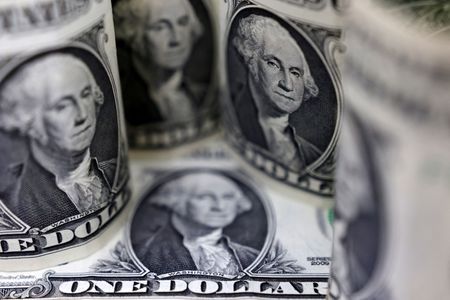By Rae Wee
SINGAPORE (Reuters) – The dollar was mixed on Wednesday after a modest but short-lived boost following better-than-expected U.S. retail sales data, as traders focused on the prospect of Federal Reserve rate cuts as early as September.
The New Zealand dollar rose as data showed non-tradeable inflation higher than expected in the second quarter, even as the headline figure missed expectations. The kiwi last gained 0.46% to $0.6078.
Data on Tuesday showed U.S. retail sales were unchanged in June as a drop in receipts at auto dealerships was offset by broad strength elsewhere, a display of consumer resilience that bolstered economic growth prospects for the second quarter.
While the dollar initially got a lift on the back of the data, it failed to sustain its gains as the report did little to alter market bets for a Fed cut in September, which is now fully priced in.
Against the greenback, the euro last bought $1.0897, hovering near a roughly four-month high hit at the start of the week.
The dollar index languished near a one-month low and last stood at 104.26, while the Australian dollar fell 0.05% to $0.6730.
“Ultimately, the story that I think best describes it is that the markets have chosen the story of a Goldilocks economy,” said Kyle Rodda, senior financial market analyst at Capital.com.
“Yes, retail sales are solid, at least on a nominal basis, and consumer demand is strong. But the more important data is the inflation data, and that’s telling the market that the Fed is in a position to cut fairly soon.”
Elsewhere, sterling was little changed at $1.2972, ahead of UK inflation data due later on Wednesday.
Expectations are for consumer prices to have cooled further in June, which could add to the case for an imminent easing cycle from the Bank of England.
“We expect June’s UK inflation report to further cement expectations of an interest rate cut at the Bank of England’s August meeting,” said Henk Potts, market strategist at Barclays Private Bank.
“We project that the headline consumer price index could continue to ease hitting 1.9% (year-on-year), driven by disinflationary pressures in both core goods and services.”
The yen was last 0.1% lower at 158.47, as traders remained on alert for any intervention from Japanese authorities to prop up the currency after they had likely done so last week.
Bank of Japan data released on Tuesday suggested Tokyo may have spent 2.14 trillion yen ($13.5 billion) intervening on Friday last week. Combined with the estimated amount spent on Thursday, Japan is suspected to have bought nearly 6 trillion yen via intervention last week.
(Reporting by Rae Wee. Editing by Sam Holmes)





